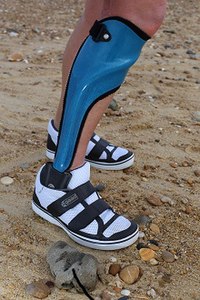
Photo from wikipedia
Background: Gait speed declines with increasing age, but it is unclear if gait speed preferentially correlates with leg muscle strength or mass. Objective: We determined the relationship between gait speed… Click to show full abstract
Background: Gait speed declines with increasing age, but it is unclear if gait speed preferentially correlates with leg muscle strength or mass. Objective: We determined the relationship between gait speed and (1) leg muscle strength measured at 3 lower extremity joints and (2) leg lean tissue mass (LTM) in healthy young (age: 25 years, n = 20) and old (age: 70 years, n = 20) adults. Methods: Subjects were tested for maximal isokinetic hip, knee, and ankle extension torque, leg LTM by bioimpedance, and gait performance (i.e., gait speed, stride length) at preferred and maximal gait speeds. Results: We found no evidence for a preferential relationship between gait performance and leg muscle strength compared with gait performance and leg LTM in healthy young and old adults. In old adults, hip extensor strength only predicted habitual gait speed (R2 = 0.29, p = 0.015), whereas ankle plantarflexion strength only predicted maximal gait speed and stride length (both R2 = 0.40, p = 0.003). Conclusions: Gait speed did not preferentially correlate with leg muscle strength or leg LTM, favoring neither outcome for predicting mobility. Thus, we recommend that both leg muscle strength and leg LTM should be tested and trained complementarily. Further, hip and ankle extension torque predicted gait performance, and thus we recommend to test and train healthy old adults by functional integrated multiarticular rather than monoarticular lower extremity strength exercises.
Journal Title: Gerontology
Year Published: 2017
Link to full text (if available)
Share on Social Media: Sign Up to like & get
recommendations!